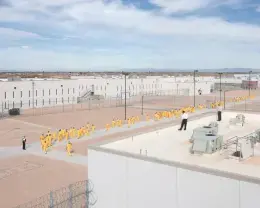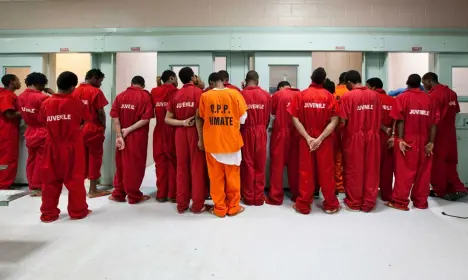Lesson Plan June 28, 2021
Slavery, Mass Incarceration, and America’s Founding Ideas and Documents
Grades:
Warm-up: What do you notice about this photograph taken inside a jail?
Introducing the Resources:
- "Slavery Gave America" by Bryan Stevenson
- "The Idea of America" by Nikole Hannah-Jones
- "Slavery to Mass Incarceration" video by Equal Justice Initiative
Essential Questions:
- What is mass incarceration?
- Are Black and Brown men incarcerated at a much higher level than any other demographic in America?
- How is mass incarceration in modern America similar to slavery in colonial America?
- How does mass incarceration, much like slavery, significantly conflict with America’s foundational ideas and documents?
Discussion:
- What details, information and statistics in the articles can you confirm as evidence to answer the essential questions above?
- What information in this text is new to you or challenges the story of American history that you have already learned in school?
- What questions do you have about what you have read?
Conclusion:
- Writing Assessment: How does mass incarceration, much like slavery, significantly conflict with America’s foundational ideas and documents, especially the line above from the Declaration of Independence?

Lesson Summary
In this lesson students will read to understand how Black and Brown men are currently incarcerated in America at a much higher level than any other demographic. Students will evaluate the relationship between slavery and the current criminal-justice system. They will close read two anchor texts from the New York Times 's 1619 Project, i.e., an excerpt from the article “Slavery Gave America…” and an excerpt from the article "The Idea of America." Using these texts, other visuals, and a video as their background knowledge resource bank, students will write to make and support a claim about mass incarceration and the ways in which this practice, much like slavery, significantly conflicts with America’s foundational ideas such as “all men are created equal.”
Lesson Objectives
Students will be able to:
- State and explain several statistics and facts related to the current mass incarceration of Black and Brown men in America.
- Evaluate and draw conclusions about the relationship between American slavery and mass incarceration in modern America.
- Make and support a claim about the ways in which slavery and mass incarceration both markedly conflict with America’s foundational ideas and documents.
Essential Questions
- What is mass incarceration?
- Are Black and Brown men incarcerated at a much higher level than any other demographic in America?
- How is mass incarceration in modern America similar to slavery in colonial America?
- How does mass incarceration, much like slavery, significantly conflict with America’s foundational ideas and documents?
Black Lives Matter Guiding Principles
- Collective Value means that all Black lives, regardless of actual or perceived sexual identity, gender identity, gender expression, economic status, ability, disability, religious beliefs or disbeliefs, immigration status, or location, matter.
- Empathy is one’s ability to connect with others by building relationships built on mutual trust and understanding.
- Diversity is the celebration and acknowledgement of differences and commonalities across cultures.
- Loving Engagement is the commitment to practice justice, liberation, and peace. ● Restorative Justice is the commitment to build a beloved and loving community that is sustainable and growing.
- Black Men: we are committed to building a Black man affirming space. We reject the over sexualization, criminalization and mass incarceration of our Black boys and men. Furthermore, we are committed to dismantling the school to prison pipeline, adultification of Black and brown boys, and the senseless killing of unarmed Black and brown men.
Vocabulary
Note: Please review and define the words below during the reading of each text. Students will use a Frayer model to define and better understand the word “incarceration” as this term is most crucial to their developing understanding and discovery of the content in this lesson.
- Bias: prejudice in favor of or against one thing, person, or group compared with another, usually in a way considered to be unfair.
- Consequences: a result of your actions.
- Disproportionate: too large or too small in comparison with something else. Emancipation: the fact or process of being set free from legal, social, or political restrictions; freeing.
- Hierarchy: a system or organization in which people or groups are ranked one above the other according to status or authority; pecking order.
- Humanity: the human race; human beings collectively.
- Incarceration: the state of being confined in prison; imprisonment.
- Injustice: lack of fairness or justice; unfairness.
- Presumption: an idea that is taken to be true, and often used as the basis for other ideas, although it is not known for certain; an assumption.
- Restorative Justice: Restorative justice gives victims the chance to meet or communicate with their offender to explain the real impact of the crime – it empowers victims by giving them a voice. It also holds offenders to account for what they have done and helps them to take responsibility and make amends. Restorative justice often involves a conference, where a victim meets their offender face to face.
- School to prison pipeline: the disproportionate tendency of minors and young adults from disadvantaged backgrounds to become incarcerated because of increasingly harsh school and municipal policies, as well as because of educational inequality in the United States.
- Tolerance: the ability or willingness to tolerate something, in particular the existence of opinions or behavior that one does not necessarily agree with.
Warm-up

- Facilitate a whole group discussion for students to respond to the following question about the photograph
- What do you notice about this photograph taken inside of a jail?
NOTE: Take responses until students come to the realization that all the inmates are Black or Brown men. Do not give any statistics about mass incarceration at this point. Rather, allow students to discover the statistics in the first steps of the lesson.
Texts
Slavery gave America a fear of black people and a taste for violent punishment. Both still define our criminal-justice system.
By Bryan Stevenson
Summary: The excerpt provides information about mass incarceration and the central understanding that this practice of mass incarceration and excessive punishment is analogous to the legacy of slavery.
The Idea of America
By Nikole Hannah-Jones
Award-winning investigative journalist Nikole Hannah-Jones provides an expansive essay on why “Black Americans, as much as those men cast in alabaster in the nation’s capital, are this nation’s true ‘founding fathers.’ Her essay chronicles a history of policies enacted to profit from and disenfranchise Black Americans, and the fight not only to claim Black liberation but also to make liberation possible for ALL Americans.
Video: "From Slavery to Mass Incarceration" by Equal Justice Initiative
Procedural Steps
- Say, “Before we get into the statistics that describe what is happening in this photograph, and why we only see Black and Brown men incarcerated, we must completely understand what the term incarceration means.” Distribute the Frayer model graph for the term incarceration.
- Share the definition for incarceration, or the state of being confined in prison.
- Ask students to copy the definition into the top left box. Then ask students to complete the next three boxes in which they will use the term in a sentence of their own, provide synonyms and antonyms, and a symbol representing any aspect or visual that relates to incarceration.
- Review the Confirm-Challenge-Question note catcher for the texts “Slavery Gave America…” by Bryan Stevenson and The Idea of America by Nikole Hannah-Jones and the video From Slavery to Mass Incarceration by the Equal Justice Initiative.
- What details, information and statistics in the article can you confirm as evidence to answer the essential questions above?
- What information in this text is new to you or challenges the story of American history that you have already learned in school?
- What questions do you have about what you have read?
- Read aloud each text and watch the video with students, allowing them time to stop during and in between each text to define terms and note textual details to complete the graphic organizer prompts.
- Instruct students to review all their notes on the Confirm-Challenge-Question graph.
Conclusion
Writing Assessment: Short Response
The most important line from the Declaration of Independence reads: We hold these truths to be self-evident, that all men are created equal, that they are endowed by their Creator with certain unalienable Rights, that among these are Life, Liberty and the pursuit of Happiness.
Declaration of Independence
How does mass incarceration, much like slavery, significantly conflict with America’s foundational ideas and documents, especially the line above from the Declaration of Independence?
This lesson was generously shared with the Pulitzer Center from the Office of Culturally and Linguistically Responsive Initiatives at Buffalo Public Schools in Buffalo, New York.
ELA9-10W1: Write arguments to support claims that analyze substantive topics or texts, using valid reasoning and relevant and sufficient evidence.
ELA9-10W6: Conduct research to answer questions, including self-generated questions, or solve a problem.
ELA9-10W7: Gather relevant information from multiple sources and assess the usefulness of each source in answering the research question